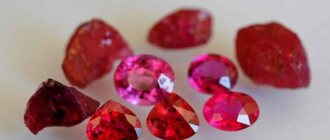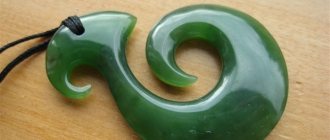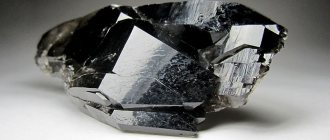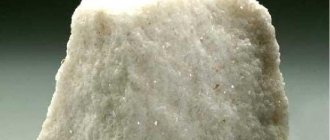There are many known deposits on earth where emeralds are mined: in Russia, France, Namibia, Canada, Bulgaria, India, South Africa, etc. There are about 30 countries in total.
- Emeralds belong to the beryl group: precious stones of the first order.
- An ideal emerald is a transparent mineral with a uniform, rich grass-green color.
- The color of the mineral is given by chromium or vanadium oxides.
- A yellow tint may be present in the stone due to iron impurities.
- The crystals are usually prism-shaped and up to 5 cm long.
- Large, densely colored gems weighing more than 5 carats are more expensive than diamonds.
What is emerald
Emerald is a first category gemstone, which is a transparent variety of beryl. The gem has a crystalline structure, the highest quality specimens have high transparency, dichromism (the ability to change one shade of color to another). Most emeralds are dark and pale green, sometimes there are specimens with a yellowish or bluish tint.
In terms of its value, the mineral is comparable to sapphire, diamond and ruby. The price of the stone depends on the degree of transparency, uniformity and color saturation, the presence of defects - bubbles, microcracks, inclusions.
Artificial minerals
Stones grown in laboratory conditions are significantly superior in physical parameters to specimens of natural origin. But the cost of natural crystals is higher.
Hydrothermal stones are produced from emerald chips that remain after processing real stones. The waste is placed in an autoclave, where high temperatures and chemicals dissolve the starting material. Then the container with the solution is placed in the cold, which ensures the crystallization process.
It should be noted that artificial emeralds are not considered fake. But information about the laboratory origin of the stones must be indicated in the description of the jewelry.
Mining emeralds
People have been mining emeralds since ancient times. Depending on geological conditions, there are deposits in nature:
- pegmatite – igneous vein rocks;
- pneumatolytic – minerals formed by hot vapors and gases;
- placer types of deposits - accumulation of clastic rocks.
Depending on the type of formation, there are several ways to extract the gemstone.
Extraction methods
If the emerald deposit is located close to the surface of the earth, the gems are mined by open-pit mining:
- to find stones, a quarry is dug out manually or with a bulldozer, and the top layers of soil are cut off;
- When a precious mineral is discovered, large pieces of rock are brought to the surface of the earth and gems are extracted from them.
Often, years of open-pit mining turn out to be fruitless - emeralds suitable for processing are not found in the rocks.
In addition to the open method, emeralds are mined using the shaft method. It implies large scale production and labor automation. In small mines they use simple tools and low-power explosives. In large mines, special conditions are maintained: good ventilation, pumping out water, and a temperature of 15 degrees.
Production stages
In the mines where emeralds are mined, the work process is divided into several important stages:
- First, the rock is studied visually. When green crystals are found on the surface, they are removed manually using special devices.
- Then, a cavity is punched in the rock into which explosives are placed. For these purposes, gentle explosives are used to minimize the breaking of precious stones.
- Rock fragments formed after the explosion are loaded into a trolley and sent to the surface of the earth.
- The raw materials are dried within 48 hours, after which they are sent to a gemologist for sorting.
- The gemologist responsible for processing raw materials saws and crushes gems in the direction of cracks and chips.
- The minerals, separated into fractions, go to an automated sink, where clay, layers of dirt and dust are washed off.
- At the last stage, the resulting stones are sorted again, selecting valuable images of “jewelry quality”. After sorting precious stones, some waste unsuitable for jewelry remains.
With good primary processing of emerald raw materials, in the hands of a jeweler the stones take the given shape and are cut. If sorted and cut poorly, during the cutting process, emeralds show numerous defects: cracks, chips, inclusions.
Methods and research
- Microscopy
Emeralds, even of very high quality, usually have many inclusions, and their study is an extremely important tool for diagnosing the geographical origin of emeralds. Gemologists divide emeralds into two large groups according to the inclusions observed in them: emeralds with “jagged” and “block” inclusions. These groups generally correspond to the two genetic groups of emeralds (hydrothermal and slate) and allow us to determine whether an emerald is Colombian or definitely not from Colombia. More detailed information about the genetic groups of emeralds is provided in the conclusion to this article.
Some inclusions are typical only of emeralds from specific deposits. A striking example of this is the inclusions in the well-studied emeralds of Colombia. They have a number of characteristic inclusions that allow them to be distinguished from emeralds from other deposits. However, such inclusions are often absent from the emerald under study, and then it is extremely difficult to distinguish it from other emeralds of hydrothermal deposits (for example, Afghan and Chinese) based on the study of inclusions.
- Spectroscopy
Registration and interpretation of absorption spectra in the visible and near-infrared regions (300-1000 nm) makes it possible with high probability to determine whether an emerald belongs to a hydrothermal or shale genetic group and to separate stones from Colombia, Afghanistan and China from emeralds from other deposits. Such conclusions are made based on the features of the absorption spectra associated with the main elements chromophores in emerald - Cr3+, Fe2+, Fe3+ and V.
- Chemical analysis of trace elements
Interpretation of data on the content of trace elements is a very informative diagnostic tool. The beryl crystal lattice has several unique positions of varying size and coordination that can be occupied by different trace elements. For diagnostics, data on the concentrations of Li, K, V, Cr, Fe, Rb and Cs are usually used. Today, there are several different methods for determining data on the concentration of impurity elements, differing in accuracy and lower detection limit. Comparison of the data obtained for the diagnosed emerald on the chemical composition of its microelements with similar data for emeralds of known origin often makes it possible to accurately determine the geographical origin of the gemstone.
No less important are other research methods introduced by our laboratory into the standard methodology for diagnosing emeralds. Such methods are the photoluminescence spectral method and Raman spectroscopy (Raman spectroscopy), used in conjunction with X-ray diffraction analysis.
In the gemological laboratory of the Gemcenter of Moscow State University, over more than 25 years of its work, a large number of emeralds from different deposits have been studied, some of which are currently in its own reference collection of samples with precise reference to the deposits. In 2021, the collection was significantly expanded with Russian Ural emeralds. In addition, to study the properties of emeralds, the Gemological Center of Moscow State University was provided with collections of Colombian and Zambian samples with reliable information about the place of their extraction. Employees of the gemological laboratory studied and analyzed the properties and characteristics of all available emeralds with a known geographical origin, the most important of which are the nature of the inclusions and internal features of the emeralds, their spectral features and data on the impurity chemical composition. In this article we present some results of our research.
Emerald deposits
Today, only a few countries can boast of large deposits of high-quality emerald. Green gems are mined in small quantities in more than 30 countries around the world.
Africa
Africa ranks second in the world in terms of production of green gems. Emerald deposits were discovered here relatively recently - at the beginning of the 20th century. Today, operating African mines are located in Tanzania, Zimbabwe, and Zambia. Stones mined on the continent are of high quality, rich blue-green color and small in size.
Brazil
Brazil is the world's leading supplier of emeralds. Their main deposits are located in the east of the country, in Bahia and Minais Gerais. But Brazilian gems are not of first-class quality; they are colored rich green with a yellowish tint.
Interestingly, emerald mining in Brazil is mainly carried out by freelance miners. They extract the mineral mainly by open-pit mining, since they do not have the money to develop a mine or purchase expensive equipment.
India
In India, emeralds are mined using open pit and underground mining methods. The largest deposits of the precious mineral are located in Rajasthan and near the city of Ajmir. In most small deposits, workers work on the surface.
Colombia
More than half of the world's emerald production comes from Colombia. High quality gems are found here, distinguished by their large sizes and pure, rich color. Most of the country's mines are located in the Eastern Cordillera. Often, mines are attacked, resulting in crystals ending up in smuggled markets.
Russia
Domestic emerald mines are located in the Urals. Russian gems are distinguished by their high density and large size. The Russian Federation competes with Colombia in the quality and richness of the color of stones. But there are not as many Ural gems as Colombian ones.
Historical excursion
Egypt and the Arabian Peninsula are considered the world's first sources of emeralds. The “Cleopatra mines” were mined there four thousand years ago. When the Colombian stones were introduced to Europe, they were preserved, only to be rediscovered three hundred years later.
- The second oldest emerald deposit is the Aswan mines near the Red Sea. About five thousand miners worked simultaneously in mines 200 m deep. They worked at night because it was believed that the mineral does not tolerate light.
- The emerald fever in Colombia began with the conquistadors in the 16th century. The Spaniards had to work in extreme conditions, fighting with the Indians, on whose ancestral lands there were stones.
- Ural emeralds were discovered near Yekaterinburg by the “boss” of a local cutting company, Yakov Kokovin, in the mid-19th century. A hundred years later, they were fundamentally studied by the guru of Soviet geology, Academician Alexander Fersman. More than 15 tons of gem were obtained.
However, during the Soviet era (until the early 90s), the main asset of the Urals was considered to be beryl, necessary for strategic industries. Emerald was mined along the way.
Cost of emeralds
The price of an emerald depends on its quality: purity and color saturation, size, cut shape, presence or absence of defects. Depending on this, the cost of different specimens ranges from 18,000 to 600,000 Russian rubles per carat.
In the jewelry market, counterfeits - chrome diopsides - are often passed off as real stones. They have a visual resemblance to emerald, but most methods of jewelry cutting are not applicable to them.
Ancient debris
Ancient debris
Photo: minecraft-ru.gamepedia.com
This special ore can only be found in the “Nether” at levels from 8 to 22 blocks. Mining Ancient Debris requires a Diamond or Netherite Pickaxe. Ancient debris can be used to obtain Netherite Ingots, which are needed to create Netherite weapons and armor. In addition, such ingots can be used to obtain netherite tools.
Decorations
Jewelry with emeralds is always in sight, they look rich and attract the attention of others. Jewelers often combine green gems with sapphires and diamonds in expensive jewelry. For the setting of stones, yellow, red and pink gold, silver, and platinum are used.
Bracelets, pendants, large earrings and necklaces with emeralds are more suitable for special occasions rather than for everyday wear. More discreet options - elegant emerald rings or earrings without unnecessary details, will successfully complement a business suit or office look.
Dragon egg
This is the rarest block in the game. It can only be obtained by killing the dragon at the top of the portal from the End. To get an egg, you need to break the block next to it, and then hover your mouse over the egg block. After this, it will collapse and fall out. You can also move the egg with a piston. Remember that the egg can only be obtained once.
This block has no standard uses. The egg is not involved in crafting or building. It can be used as room decoration or to build a random number generator. If you install the DragoMounts modification, then you can grow your own dragon, which will serve as transport or protection for you.
Photo: minecraft-ru.gamepedia.com
Related news
Players named the most annoying mobs in Minecraft
How to distinguish real from fake?
Semi-precious varieties of beryl, non-precious minerals and artificial crystals are often passed off as emeralds. You can distinguish a natural stone from a fake by the following characteristics:
- Emerald crystals resemble pieces of green velvet. Too pronounced shine and sparkling transparency are more characteristic of glass that imitates a natural gem.
- It is also worth focusing on the cost of the precious mineral. There are no large transparent stones at an attractive price; they cost a fortune.
- The presence of a yellow or blue tint, slight cloudiness, the presence of small cracks or inclusions indicates the average quality of the green gem, but guarantees that the stone is natural.
Products with real emeralds do not tolerate chemicals and are resistant to prolonged exposure to bright sunlight.
In search of gems
Today, industrial tourism is developing at the Mariinsky mine, and anyone can feel like a prospector and even find an emerald. The standard excursion program consists of two stages. In the demonstration rooms you can see emerald specimens, various beryl druses, phenacite samples and dozens of other minerals. Guests are taught to distinguish natural stones from artificial ones and are shown what minerals look like under a microscope.
The second part of the excursion program includes a trip to the observation deck on board the mine quarry. A mine opening was built there - a drift simulating an underground mine where real equipment was installed. Everyone can feel like a prospector at the beginning of the 20th century: washing ore the old fashioned way and looking for various minerals. All finds will have to be left on the territory of the enterprise, but there is a souvenir shop at the mine, where in the near future it will be possible to purchase products and souvenirs made from precious and ornamental minerals.
Magic properties
For example, emerald is considered a stone of wisdom, and jewelry with this stone was worn by sages, philosophers, people of science and everyone who put the spiritual above the material. Maybe this belief is connected with Solomon, who highly revered emeralds. Emerald is also considered a strong protective talisman that will protect you from misfortunes at home and on long journeys. And, surprisingly, there used to be a belief that emeralds protected virginity. And if a virgin breaks her virginity, her stone will split.
Cut
Considering the high cost of uncut emerald, only a highly qualified specialist can cut it.
Several methods are used to cut such material:
- Spherical - allows you to process expensive specimens with a large number of cracks and inclusions;
- Stepped – is an octagonal shape, the so-called “emerald cut”.
It is worth noting that stones containing a large amount of impurities are considered more expensive, since this factor clearly demonstrates their natural origin.
Interesting Facts
- Colombian guajeros are free emerald miners who mine the gems on their own. Today, almost all deposits have been sold to foreign investors. When unsorted stone is thrown from deposits, people try to take the pieces, even leading to violence.
- People working in the Colombian mines undergo a week-long training course and use only the simplest, cheap tools, which is why their lives are always at risk. Their working day is 12 hours, and their pay is usually limited to a bowl of stew. At the same time, workers are given a lot of local alcoholic drink - guarapo.
- Muzo, a region of the country where rich mines are located, is almost completely controlled by paramilitary groups.
- It is believed that the Indian Sultan Shah Jahan, on whose orders the famous Taj Mahal was built, wore a gem with sacred texts engraved on it. Hence the origin of the legend that the gem is a stone of love - after all, the palace built by the Sultan is considered a symbol of high feelings.
- The largest specimen was brought from Brazil, its weight is 28 kg.
- The emerald deposit near Aswan has long been considered a fiction. However, in 1818 it was reopened.
Mining emerald is important for people, because it is not only beautiful, but also has many useful qualities. This stone is widespread on the planet, so we can hope that natural emerald will be used more often than synthetic ones for a long time. Read more about hydrothermal emerald →











